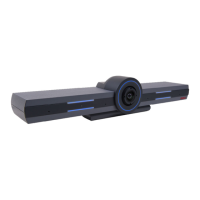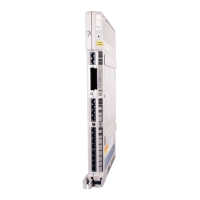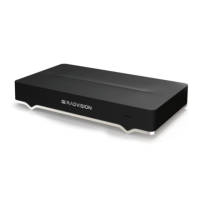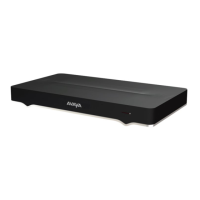– Touch and drag over the panel to move cursor over the device GUI
– Short touch to emulate a click
– Long touch to emulate a long press
– Two fingers touch to emulate ‘Back’
– Using a mouse (computer)
– Click left button and drag to move
– Short click to emulate a click
– Long click to emulate a long click
– Right click to emulate ‘Back’
Figure 11: Remote Device Panel with move area (left) and scroll area (right)
Important
• See Known Issue section for a limitation in this feature when using Web Browsers on iOS
mobile devices
System OS Management
Once the CU360 Video-collaboration Application is configured and running, you can activate the
standard Operating System Navigation bar by moving the mouse pointer at the bottom of the
screen.
Note:
• The mouse pointer can be activated by pressing the “Mouse” button on the
remote-control.
OS Navigation Bar
Figure 12: Standard System Navigation Bar – A10
Back (Triangle): Takes you back a level in an app, or back a page in a browser, etc. Right
clicking with the mouse in any place on the screen has the same effect.
Home (Circle): Returns to the main home screen (device desktop).
Overview or Recent or Intent (Square or Split Rect): Display the list of the recently used apps,
in a side-by-side list. To select an app for Split screen, press with the mouse on the app icon and
select “Split screen”; the available screen will split in two and you will see the first app on the left;
then you can select the app for the remaining part of the screen.
Figure 13: Select the Leftmost App for Split Screen – A10
Pressing the split rect icon again, you can change the app selected for the rightmost portion of the
screen or rotate among all the open apps. To stop Split screen, you need to enlarge the portion of
the screen reserved for one of the apps by dragging the separation bar.
Volume Controls(new in Android 10): Show the audio gadget and decrease/increase the audio
level. Android uses separate audio streams for playing music, alarms, notifications, the incoming
call ringer, system sounds, in-call volume, etc.. This allows users to control the volume of each
stream independently. By default, pressing a volume control modifies the volume of the active
audio stream. If your app isn't currently playing anything, hitting the volume keys adjusts the music
volume.

